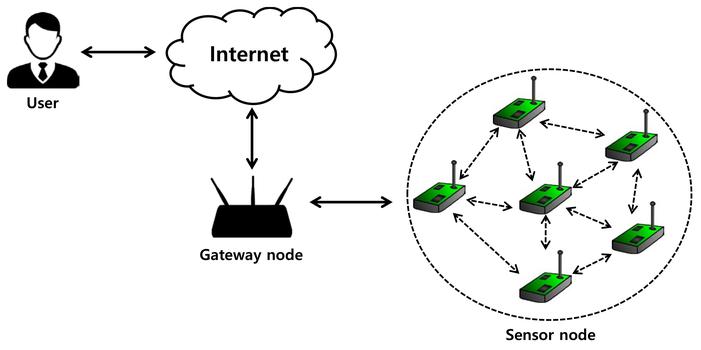Concept introduction
sensing network refers to a huge network that combines infrared sensors, global positioning system, laser scanner and the Internet, and the Internet. Let all items are connected to the network, facilitate identification and management, thus also called "Internet of Things". For example, we must now look at, taste, touch, and smell them to form a comprehensive judgment on some kind of food. But if you upload these perceived information to the web, you can always understand the color of this food, this is the charm of the sensory technology.
Network Characteristics
Traditional sensors are gradually miniaturizing, intelligent, information, networking, is experiencing a Dumb Sensor → Smart sensor (Smart SENSOR) → Embedded Web Sensor's connotation has a rich development process.
With the rapid development of Micro-Electro-Mechanism System, MEMS, SMS, SOC, SYSTEM ON CHIP, wireless communication, and low-power embedded technology, wireless sensing network (WiReless Sensor NetWorks, WSN) technology has emerged, and a transformation of information awareness is brought about by low power, low-cost, distributed and self-organized characteristics. This has become a new hotspot in all fields.
Wireless sensor network is an interdisciplinary technology, which is made up of a large number of inexpensive micro sensor nodes deployed in the monitoring area, one multi-hopping from a wireless communication method. MEMS-based micro-sensing technology and wireless networking technology give a broad application prospect for wireless sensor network. These potential applications can be summarized as: military, aviation, anti-terrorism, explosion-proof, disaster relief, environment, medical, health care, home, industrial, business, etc.

WSN will be one of the four major technical industries in the world, will set off a hot wave of new industries.
In 1999, the US Commercial Weekly was listed as one of the 21st technologies in the 21st century; in 2003, the US MIT Technical Comments were listed in the report of future technology development. Change one of the top ten new technologies in the world. The US Presidential Science and Technology Advisory Commission pointed out in the "Federal Energy and Development Plan for 21st Century", and the wide application of industrial wireless technology will increase industrial productivity by 10% and reduced emissions pollution by 25%.
Development History
As early as in the 1970s, there was a prototype transmission, and the sensor network prototype, and we returned it. The first generation sensor network.
With the continuous development and progress of the relevant discipline, the sensor network also has a comprehensive processing capability that acquires a variety of information signals, and consists of information synthesis by associating the sensor controller. And the sensor network of processing power, this is the second generation sensor network.
starts from the end of the last century, fieldbus technology began to be applied to sensor networks, and people use their intelligent sensor networks, a large number of multi-function sensors are used, and wireless technology is used, and the wireless sensor network is gradually formed. Wireless sensor networks are a new generation of sensor networks that have a very broad application prospect. Its development and application will bring far-reaching influences to all areas of human life and production. Developed countries, such as the United States, very important to the development of wireless sensor networks.
The US Department of Communications proposed "National Intelligent Transportation System Project Plan" in 1995, which is expected to be fully put into use in 2025. The plan attempts to effectively integrate advanced information technology, data communication technology, sensor technology, control technology and computer processing technology and is used to establish a large-scale real-time real-time efficient integrated transport management system throughout the surface traffic management. This new system will effectively use sensor networks to communicate traffic management.
The US Army puts forward the "Deli Sensor Network Communication" program in 2001, and is approved during the 2001-2005 fiscal year. Its basic idea is to set a large number of sensors on the battlefield to collect and transfer information, and filter the relevant original data, and then transfer those important information to each data fusion center, bringing a lot of information set into a battlefield panorama. picture. When the participants need it, they can be distributed to them, making them greatly improved on the performance of the battlefield.
In May 2002, the Sandia National Laboratory in the United States cooperated with the US Department of Energy to jointly study the biochemical weapon attacks that were targets as soon as possible, and the system of prevention of countermeasures was taken in time. It belongs to the important part of the American Energy Terrorism Countermeasures. The system sets chemical sensors and network technologies of poisonous gases.
The US Natural Science Foundation of China has developed a wireless sensor network research program in 2003, established a sensor network research center in Los Angeles, California, and the United States, the University of California, Berkeley, Southern California, etc. Research Project of Intelligent Sensor.
Intel released the "New Calculation Development Plan Based on Micro Sensor Network" on October 24, 2002. Planning claims that Intel will be committed to the application of micro-sensor networks in preventive medical, environmental monitoring, forestry extinguishing and seabed plate surveys, planetary exploration.
my country is included in the National "Eleventh Five-Year Plan" and "National Medium and Long-term Science and Technology Development Outline", and WSN is also listed as support in the national 863, 973 program. project.
